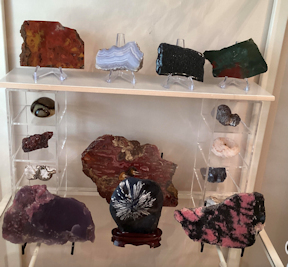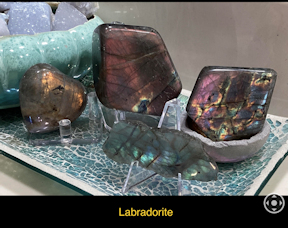Take a look at what club
members are doing with what they have learned
We have a lot of talented members. This is the place they can show
their work. By doing so encourage others to pursue their own projects.
Members with their work shown here are willing to share some of
the ups and downs and ins and outs that got them where they are
today.
(click on a members name to jump to their projects)
Don Hill
Vivian Melof
Ivey Cook
Jinger Glasgow
Larry & Diane Carby
Levan & Yvonne Foster
John & Bonnie Gaston
John and Judy Wild
Larry Yednak
Bryan Thomas
Cabbing or cabochon cutting is probably the most common form of
lapidary arts. Cabochons or "cabs" are gems cut with a
flat bottom and a curved or domed top. If you've seen opal or turquoise
jewelry, you've probably seen cabs.
Cabbing can be profitable. Depending on the gem material you use,
cabochons can have significant resale value. Thus, cabbing can make
a very rewarding hobby, especially if you cut gems you find yourself.
However, cabbing machines do cost more than tumblers. While cabochon
cutting is more complex than tumbling, you can become proficient
with a little practice. A word of warning: cabbing can be highly
addictive!
Don Hill
Suiseki and viewing stones, cabbing and wire
wrap are just a few of Don's lapidary crafts
Go to the top
Vivian Melof
Vivian has been gathering her collectiion of exceptional specimens
for a number of years. Growing the collection from anyplace she
discovered them. Yard and estate sales, gem & mineral shows, rock
shops, any where a beautiful piece caught her eye and decided she
couldnt live without it, she made it hers.

 
Go to the top
Ivey Cook
The simplest form of lapidary, gemstone tumbling requires minimal
equipment. You put rough gem material into a tumbler, a revolving
barrel with abrasives. Progressively finer abrasives are used until
the gem obtains a polish. This process closely resembles what happens
to rocks in a stream or on the beach. However, tumbling produces
much higher polish levels.
Ideal for children and a great family pastime, it's a great way
to work stones collected on family vacations or rock hunting. Plus,
the results are sensational! You can also purchase inexpensive settings
and turn tumbled stones into jewelry pieces. They make wonderful
homemade gifts.
Go to the top
Jinger Glasgow
Stained glass is not cheap, nor is it a cheap hobby to begin. You
need a lot of equipment, such as a grinder, a good glass cutter,
protective gloves, solder, copper foil, fluxes, special tools, and
the uncut glass is expensive as well. You need a lot of practice
to make those difficult glass cuts so things fit together smoothly.
Practice, Practice, Practice is what I did.
If people like your work, they will buy your glass. I started selling
my glass in some independent shows which were also successful, and
I did private orders as well. I have often repaired a piece of glass
someone had for a long time but got cracked. I gradually became
more creative, often drawing my own patterns and to be a good stained
glass artist you have to be able to visualize how colors and textures
look when placed together.
I also wrote a book 
Go to the top
Larry and Diana Carby
We have a wide range of materials that can be carved, tumbled,
or cabbed. A wide variety of rough materials ranging from inexpensive
to rare. Japer rough is a favorite for people who are learning to
cut cabochons because it's an inexpensive material that is easy
to work with, and it makes beautiful stones. Other good lapidary
rough for beginners is agate, chalcedony, and stabilized turquoise.
Go to the top
Levan and Yvonne Foster
Of all the lapidary arts, gem faceting has the greatest profit
potential. If you can imagine a diamond in a typical engagement
ring, you're likely visualizing a faceted gem. Geometrically arranged,
flat surfaces typically cover the surface of such a diamond. Each
of these flat surfaces is called a facet.
Faceting should bring out the brilliance of a gem. The bottom facets
reflect the light entering the stone and return it to the viewer.
(Don't confuse brilliance with dispersion or "fire," the
multicolored flashes you see coming out of diamonds and some other
gems).
Go to the top
John and Bonnie Gaston
If you are thinking about collecting the stones out in nature,
if possible join a gem and mineral club that goes on field trips,
or befriend a rockhound who still collects and is willing to take
you out. They will be able to describe and show you what looks promising.
Take a hammer and water spray bottle to try to knock off a section
and application of water can give you an idea what colors and patterns
you may find inside before you spend time digging it out and hauling
it to a rock saw to slice. They really can be like a box of chocolates,
something with a promising exterior can be a dud, and sometimes
a plain but gemmy-looking rock can be stunning inside. OR you can
just cut to the chase and go to a rock show like the one in Quartzsite,
AZ and buy slabs.
One other note about slabs. If you buy them, look for seams and
fractures. One wise old lapidary artist told me to drop the slab
from a few feet up if possible and anything that holds together
should stand up to the pressures of cutting and polishing. If you
can not do that, you may want to spend some time stablizing the
stone with resin or glue.
Go to the top
John and Judy Wild
We are Wild River
Go to the top
Larry Yednak
Geoligy
Go to the top
Bryan Thomas
Geology
Go to the top
| 

